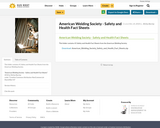
This folder contains 41 Safety and Health Fact Sheets from the American Welding Society.
- Subject:
- Practical & Applied Arts
- Welding
- Material Type:
- Lesson
- Primary Source
- Syllabus
- Date Added:
- 10/23/2018

This folder contains 41 Safety and Health Fact Sheets from the American Welding Society.

Manage classroom noise with bouncing balls!

Filtering is the process of removing or separating the unwanted part of a mixture. In signal processing, filtering is specifically used to remove or extract part of a signal, and this can be accomplished using an analog circuit or a digital device (such as a computer). In this lesson, students learn the impact filtering can have on different types of signals, the concepts of frequency and spectrum, and the connections these topics have to real-world signals such as musical signals. Students also learn the roles that these concepts play in designing different types of filters. The lesson content prepares students for the associated activity in which they use an online demo and a variety of filters to identify the message in a distress signal heavily corrupted by noise.

Students learn the basic principles of filtering as well as how to apply digital filters to extract part of an audio signal by using an interactive online demo website. They apply this knowledge in order to isolate a voice recording from a heavily noise-contaminated sound wave. After completing the associated lesson, expect students to be able to attempt (and many successfully finish) this activity with minimal help from the instructor.

Through investigating the nature, sources and level of noise produced in their environment, students are introduced to the concept of noise pollution. They learn about the undesirable and disturbing effects of noise and the resulting consequences on people's health, as well as on the health of the environment. They use a sound level meter that consists of a sound sensor attached to the LEGO® NXT Intelligent Brick to record the noise level emitted by various sources. They are introduced to engineering concepts such as sensors, decibel (dB) measurements, and sound pressure used to measure the noise level. Students are introduced to impairments resulting from noise exposure such as speech interference, hearing loss, sleep disruption and reduced productivity. They identify potential noise pollution sources, and based on recorded data, they classify these sources into levels of annoyance. Students also explore the technologies designed by engineers to protect against the harmful effects of noise pollution.

Students learn the connections between the science of sound waves and engineering design for sound environments. Through three lessons, students come to better understand sound waves, including how they change with distance, travel through different mediums, and are enhanced or mitigated in designed sound environments. They are introduced to audio engineers who use their expert scientific knowledge to manipulate sound for music and film production. They see how the invention of the telephone pioneered communications engineering, leading to today's long-range communication industry and its worldwide impact. Students analyze materials for sound properties suitable for acoustic design, learning about the varied environments created by acoustical engineers. Hands-on activities include modeling the placement of microphones to create a specific musical image, modeling and analyzing a string telephone, and applyling what they've learned about sound waves and materials to model a controlled sound room.

Students are introduced to the sound environment as an important aspect of a room or building. Several examples of acoustical engineering design for varied environments are presented. Students learn the connections between the science of sound waves and engineering design for sound environments.

Students learn the decibel reading of various noises and why high-level readings damage hearing. Sound types and decibel readings are written on sheets of paper, and students arrange the sounds from the lowest to highest decibel levels. If available, a decibel meter can be used to measure sounds by students.

Students follow the steps of the engineering design process to create their own ear trumpet devices (used before modern-day hearing aids), including testing them with a set of reproducible sounds. They learn to recognize different pitches, and see how engineers must test designs and materials to achieve the best amplifying properties.

This is the last of five sound lessons, and it introduces acoustics as the science of studying and controlling sound. Students learn how different materials reflect and absorb sound.